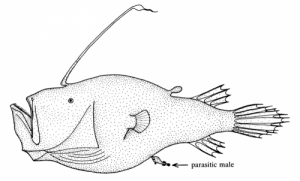Gender Reveal: Fish
“Is that fish a girl or a boy?” is a common question we get asked at the Aquarium. With some species it is a very easy question to address but with others it can be a bit more complicated. (Sometimes the answer can even be both!)
If a species is sexually dimorphic, males and females will look different from each other. Sometimes this is just a subtle variation in color or shape but it can also mean the two sexes look radically different from one another. A good example of this is a species of angler fish. The females of this species can grow to over a foot long, while males only grow to about half an inch!
Some species of fish show no sexual dimorphism and it can be impossible to tell the difference between males and females without looking inside the animal’s body. For some species at the Aquarium we can make an educated guess based on mating behaviors, but for others we just don’t know. The green moray eels in the Shark Gallery are one example of a fish that has no sexual dimorphic traits. Both sexes look identical.
Adding another layer of complication is the fact that some fish have the ability to switch sexes throughout their lifetime while others are both male and female at the same time. This is known as hermaphroditism, and there are many different forms. There’s simultaneous hermaphroditism, seen in species of hamlets, where the animal has both male and female reproductive organs and can play either role in mating. A more common type is sequential hermaphroditism, where an animal changes from one sex to the other at some point in its life. This can be further broken down into more categories: changing from male to female (protandry), female to male (protogyny), male to hermaphrodite (protandrous hermaphroditism) or female to hermaphrodite (protandrous hermaphroditism). This phenomena is not uncommon and you may be surprised at how many fish you know that fall under one of these categories.
One of the most recognizable fish at the Aquarium is the clownfish. What some people don’t know is that clownfish are actually sequential hermaphrodites—protandry to be exact. When it comes to clownfish hierarchy, the female is dominant. She is the largest fish in the group and the next largest is her male mate. The remaining fish in the group are smaller, undeveloped and unable to breed. If the female dies, the largest male then grows and becomes female and the next fish in line matures to assume the role of breeding male.
Groupers, angelfish, gobies, damselfish and wrasses (my favorite being the rooster hogfish) all fall under the protogynous category. This means that these species start out as females and can quickly switch and become males if the dominate male leaves. This type of hermaphroditism is more common and benefits the fish by allowing them to produce the maximum number of offspring. It is a size-based reproductive strategy with large, strong males protecting the nesting sites of many smaller females. For these species it is beneficial for females to produce many offspring while small and then become males when they themselves are bigger. It is also beneficial because it’s a big ocean out there and sometimes difficult to find another member of your species let alone one of the correct sex. The ability to switch sexes means these fish have more opportunities to find a mate.
Hermaphroditism has evolved independently in fish many times and has proven to be a successful reproductive strategy throughout the animal kingdom.
Rooster hogfish are both sequential hermaphrodites and sexually dimorphic. Can you spot the differences between the female (top) and the male (bottom)?
– Kelsey Scheutzow, Greater Cleveland Aquarium Diver


